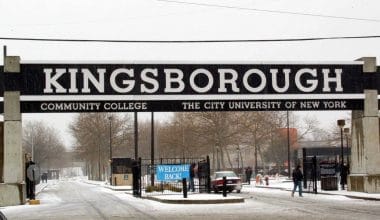Will you agree with me that trade schools offer the best practical and technical-based education? Aside from being highly practical-oriented and affordable for students, trade schools also allow you to complete your chosen program and jump straight into an entry-level career in your chosen industry within a short time.
Trade schools in Ohio, otherwise known as vocational schools, give students deep practical knowledge and skillset. It gives students opportunities to imbibe the needed skills and knowledge that will pave the way toward stable and well-paying work.
In recent years, a good number of Americans in Ohio are leaning towards the idea of enrolling in a trade or vocational school, mainly grateful to their affordability.
Though many others may still have preconceived notions or stereotypes about them, trade schools have their unique benefits and strengths that typical four-year colleges and universities do not always have.
According to the 2021 projection made by Team Northeast Ohio, there is a 34% gap between the job openings that require technical, post-secondary credentials and the number of qualified workers to fill the vacancies.
In this article, we’ll keenly discuss all you need to know about trade schools and also highlight the top trade schools in Ohio.
Carefully follow the contents outlined below and apply for the option that best suits your demand.
Table of contents
- What is a Trade School?
- What Are The Benefits of Attending A Trade School in Ohio?
- What Can You Do With A Trade Certificate?
- How to Apply to a Trade School in Ohio?
- How Long Does it Take to Complete A Trade School Certification Course in Ohio?
- How Many Trade Schools Are in Ohio?
- 13 Best Accredited Campus & Online Trade Schools in Ohio
- Columbus State Community College
- Owens Community College
- Cuyahoga Community College
- Sinclair Community College
- Cincinnati State Technical and Community College
- Hobart Institute of Welding Technology
- Great Oaks Institute of Technology and Career Development
- The Ohio State University Agricultural Technical Institute
- Kent State University
- The University of Cincinnati
- Sinclair College
- University of Northwestern Ohio
- Belmont College
- Ohio Technical College
- Frequently Asked Question On Best Accredited Trade Schools in Ohio
- Conclusion
- References
- We Also Recommend
What is a Trade School?
A trade school is a post-secondary institution created to give students the technical skills to prepare them for a particular occupation.
At a trade school, you can get a degree in fields like plumbing, nursing, health sciences, automotive technician training, wielding, and a whole lot more. Program lengths vary, but typically, they can range from anywhere from eight months to two years.
Acquiring a professional trade at a vocational or trade school may be the perfect way to realize one’s dream of a high-paying job and a personally rewarding career.
Upon completion of the program, you’ll receive a diploma or trade certificate acknowledging you successfully finished. For some programs, you can earn an associate degree, which is the degree you get from a two-year college.
What Are The Benefits of Attending A Trade School in Ohio?
Going to a trade school offers some obvious benefits. However, for the sake of emphasis, we will enumerate the benefits to be enjoyed from attending a trade school. This is something you don’t want to miss out on.
It requires less time to complete
Unlike the other colleges where you spend four years and above learning, trade schools offer the best practical education to students in less than two years.
Less time in school allows you to get more job experience and progress faster in your career. Furthermore, if you’re not in school, you won’t have to pay for those additional years of college tuition and may have to take out fewer student loans.
It is Highly Affordable
Due to the lesser number of years to be spent in a trade school, the educational cost is drastically reduced and made pocket-friendly. You won’t have to spend a whole lot on tuition and other academic exercises.
Furthermore, a good number of trade schools offer a good number of financial aid programs.
Focuses On Direct Practical Job Preparation
Trade schools focus on teaching the skills that you’ll be using in your job when you graduate.
Unlike four-year college programs that focus on scholarly learning, trade schools furnish students with hands-on practicals relevant to the particular field.
Thus, making it easier to initially find a job in that field. Also, many trade school programs are geared toward fields in which there is high demand for workers.
Availability of Lucrative Jobs
Team Northeast Ohio, a group that studies economic development in the state, projects that in 2021, a 34% gap between the job openings that require technical, post-secondary credentials and the number of qualified workers to fill the vacancies.
This alone points to the demand for skilled workers that trade and vocational schools produce. In a nutshell, higher demand is placed on technical skills.
Easy Application Process
Potential trade school students can say goodbye as well to the rigorous, neck-twisting admissions requirements and processes set by colleges and universities. However, trade and vocational schools will usually require a high school diploma, GED, or its equivalent to be accepted.
Afterward, the testing often comes shortly after the completion of the program, when students are expected to undergo industry-set exams and certifications to prove their ability and capacity to carry out their preferred profession; it’s also an efficient way of testing whether your trade school was able to properly equip you with the proper skills and knowledge you need!
Smaller Class Size
Trade schools are arranged in such a way that students are easily supervised. These manageable teacher-to-student ratios of these schools give the student an excellent individualized learning experience.
This is especially important, as trade schools often have programs that require closely supervised, hands-on learning with equipment and tools.
Read also; 10 Frequently Asked Questions About Online Colleges and Online Education.
What Can You Do With A Trade Certificate?
After completing a trade school certificate program, you can get a job directly related to the field you studied in your vocational school program. For example, if you complete a program in plumbing, you can get a job as a plumber.
Here are some of the jobs you can do with a degree from a trade school:
- Electrician
- Dental hygienist
- Plumber
- Paralegal
- Nurse
- Graphic Designer
- Welder
- Computer technician
- Aircraft Mechanic
- Cosmetologist
- Chef
- Marine mechanic
- Construction manager
- Massage therapist
- Pharmacy technician
- Landscaping
How to Apply to a Trade School in Ohio?
The application process of most trade schools is relatively simple. They have a central online application on their websites, or you can contact the school for admissions information.
Also, there tend to be no application deadlines. You can apply at any time, but you may need to wait for the beginning of your program of interest before you can register.
Additionally, after you fill out the application, you may have to interview or speak with an admissions representative.
Trade schools aren’t considered selective, and most are open enrollment. For the majority of schools and programs, you don’t have to take the SAT/ACT, and you don’t need to write an essay.
Furthermore, trade schools won’t ask for references or consider your extracurricular activities when determining admission.
How Long Does it Take to Complete A Trade School Certification Course in Ohio?
For those who don’t necessarily have four (or more) years to invest in college, attending a trade school may be the way to gain the needed skills and knowledge that will pave the way toward stable and well-paying work.
In trade schools, students are imbibed with the best of their knowledge in less than two years.
Less time in school allows you to get more job experience and progress faster in your career.
How Many Trade Schools Are in Ohio?
There are over 70 trade schools and career centers to choose from across various locations in Ohio. Public high schools in the state also provide career-technical education. In addition, for those intending to or are already taking programs in trade schools; Ohio also records a high demand for jobs requiring technical skills that are not precisely covered by four-year degrees.
Finding the most suitable on-campus and online trade schools in Ohio may prove to be quite challenging for students. However, we’ve carefully selected a list of 13 Best Accredited Trade Schools in Ohio based on certain criteria.
Our selection criteria for these programs are;
- Quality of education offered
- Accreditation status
- Graduation rate
- Total programs offered
- Student-faculty ratio, and several other relevant factors.
13 Best Accredited Campus & Online Trade Schools in Ohio
Vocational and trade schools in Ohio give students an option to attend a four-year college or university while still providing the quality education students need to get ahead.
Vocational training is delivered to students on the secondary and post-secondary levels—and in both cases, many are taking advantage of programs that will give them practical and technical skills employers are looking for.
Here’s an outline of trade schools in Ohio with information on the types of programs available to students, the career outlook for graduates, and resources for finding the right program.
- Columbus State Community College
- Owens Community College
- Cuyahoga Community College
- Sinclair Community College
- Cincinnati State Technical and Community College
- Clark State Community College
- Great Oaks Institute of Technology and Career Development
- The Ohio State University Agricultural Technical Institute
- Kent State University
- The University of Cincinnati
- University of Northwestern Ohio
- Belmont College
- Ohio Technical College
Columbus State Community College
Situated on two campuses, Columbus and Delaware, Columbus State Community College has enlisted 27,312 students. They have a myriad of associate degrees and certificates to offer in dozens of disciplines, from arts and humanities to construction and skilled trades.
The college strives to guide students in pursuing their goals and improving their lives. They put students’ success at the center of their mission.
For students seeking a quicker route to employment, the offered courses for skilled trades craftsmen are the best option. In this career path, students are trained for the job, providing them with the needed knowledge and skills in readiness for their careers. It includes Carpentry, Electrical, Plumbing, Sheet Metal, and Welding.
Apart from the associate degrees, students can also choose from several certificates, such as Intermediate Pipe and Plate TIG Welder Certificate, Intermediate Welder Certificate, Facilities Maintenance Certificate, Plumbing Module Certificate, Carpenter Apprenticeship Readiness Certificate, Construction Heavy Equipment Certificate, and many others.
Columbus State is known to offer the lowest tuition in the region. For a year, the tuition rate is around $4,738, allowing students to save as much as 40-60% on the total cost.
Financial aid options are also available, with grants, loans, and scholarships. Columbus State Community College has been recognized by the Higher Learning Commission since 1973.
Owens Community College
Owens Community College, which has campuses in the Toledo and Findlay areas, has been serving the state of Ohio for over fifty years now. It was accredited by the Higher Learning Commission (HLC) in 1976.
The small class sizes, averaging a 16:1 student-to-teacher ratio, at Owens provides a nurturing and individualized learning experience for its 7,000+ student population. Meanwhile, the Community College’s programs are arranged under four academic divisions that cover varying interests and fields of study: Business, Information, & Public Service, Liberal Arts, Nursing & Health Professions, Science and Technology, Engineering, & Mathematics (STEM).
Based on the number of graduates, Owens’ Nursing-related, Welding, and Accounting programs have proven to be the most popular choices for students.
Owens also offers programs like General Arts, which are exemplary for students who wish to shift to a bachelor’s degree upon completion, popular skilled trades like Heating, Ventilation, Air Conditioning, and Refrigeration (HVACR) Engineering Technology and Pipefitting/Plumbing, and even more niche fields like Foreign Languages and Theatre.
Owens Community College also offers academic support services like tutoring centers and a retention-focused office that provides various types of resources that students may need to complete their chosen program successfully.
Cuyahoga Community College
Cuyahoga Community College, often referred to as Tri-C, is known as the first-ever community college established in the state of Ohio. Tri-C currently enjoys high enrollment figures, serving over 26,000 students across its various campuses and training facilities.
Tri-C also has Fast Track options, non-credit community classes, and even online programs. Academic choices range from popular health careers like Emergency Medical Services (EMS) and Nursing to creative arts offerings like Graphic Design and Photography to applied industrial technology programs in some of Ohio’s high-demand fields like Plumbing and Carpentry.
Tri-C offers a total of 37 programs, with a student ratio of 21:1 and a graduation rate of 4%.
Sinclair Community College
Sinclair Community College has more than 132 years of experience in helping students achieve their dreams and succeed in the changing workforce of new and growing career fields. This college equips students with the needed skills necessary for their chosen profession.
Also, the certificate programs are designed to prepare students in a specific area, including general certificate programs and short-term technical certificates.
Some of the most notable certificate programs include Agricultural Technology, Automotive Technology, Construction Technician, Data Analytics, Electrocardiography, and many more.
Sinclair Community College has one of the lowest tuition rates in Ohio. Tuition fees can cost around $121.03 per credit hour for Montgomery Country residents, while out-of-state students have a sub-charge of $193.37, bringing their total credit cost per hour to $314.40.
For students struggling with finances, the college offers financial aid in the form of student loans, scholarships, and grants.
Cincinnati State Technical and Community College
Cincinnati State Technical and Community College offer several associate degree programs and certificates in business technologies, health and public safety, and engineering and information technologies, and a whole lot more.
In the same vein, It is also known to provide specific workforce training programs for more than 150 area businesses.
Furthermore, It offers convenient, flexible, hands-on training that is custom-designed to help you get ahead. They have accredited programs with up-to-date real-world simulations and hands-on practical instructions.
Lastly, the school offers one of the most inexpensive tuition rates. In-state tuition is at $163.64, while out-of-state tuition is at $327.28. There are also available grants, scholarships, loans, and work-study programs for students who struggle financially.
Hobart Institute of Welding Technology
The Hobart Institute of Welding Technology started in 1930 as a department of the Hobart Brothers Company. It was granted a charter by the State of Ohio in 1940—turning it into the Hobart Trade School and a nonprofit corporation governed by a board of directors.
The institute is approved by the Accrediting Commission of Career Schools and Colleges, which is listed by the U.S. Department of Education as a nationally approved accrediting agency.
The Structural Welding Program provides training for major welding processes, as well as skills in safety and technical information. Furthermore, it equips students with the vital skills that can qualify them for entry-level fabrication work, construction work, job shops, and many others.
Great Oaks Institute of Technology and Career Development
The Great Oaks Institute of Technology and Career Development in Cincinnati provides both full-time occupational programs and short-term certification programs in a variety of industries that are very much in demand in the state of Ohio, such as State Tested Nursing Assistant & Patient Care Assistant and Electro-Mechanical Maintenance Technology.
Those looking to secure a job in the plumbing industry, as well as a myriad of other similar sectors, would be best suited for Great Oaks’ full-time Construction Technologies program. It spans 900 hours within 45 weeks and is more of a jack-of-all-trades type of program that covers not only plumbing but also electrical systems, heating, ventilation, and air conditioning (HVAC), and carpentry.
Great Oaks requires applicants for this program to have earned a high school diploma or its equivalent and to be at least 18 years old. They also need a minimum assessment level of 4 for WorkKeys assessments in the following sections: Applied Math, Workplace Documents, and Graphic Literacy.
The program teaches courses like construction math, blueprint reading, material handling, use of hand and power tools, and basic safety, which are aimed at equipping future carpenters, electrical apprentices, and plumber apprentices with the needed skills and knowledge for their profession.
After completion of the program, Great Oaks also helps its students in resume writing, job interviews, and job searches.
The Ohio State University Agricultural Technical Institute
The Ohio State University Agricultural Technical Institute (commonly shortened to Ohio State ATI) in Wooster is an academic unit under the Ohio State University’s College of Food, Agricultural, and Environmental Sciences (CFAES) that offers affordable associate degrees in the state.
There are two possible options for potential students who wish to study at Ohio State University Agricultural Technical Institute. The first is an Associate of Applied Science (AAS) in the Landscape Horticulture program, while the other is an Associate of Science (AS) in the Horticultural Science program.
Landscape Horticulture is a two-year, hands-on program that covers all the necessary areas of landscaping, such as landscape design, pest control, plant identification, landscape construction, and management.
Meanwhile, the Horticultural Science program focuses more on the study of plants and materials used in landscaping, while also covering horticultural and turf management and also greenhouse production.
Presently, Ohio State ATI’s rates per credit hour are at $424.88 for Ohio residents, making them a slightly more expensive option compared to other colleges and schools in the state. However, there is a myriad of financial aid options to support interested and eligible students.
Kent State University
Kent State University College of Applied and Technical Studies offers a program in Horticulture Studies is offered. The program, which can be taken only at Kent State’s Salem campus, awards an Associate in Applied Science (AAS) degree upon completion of 60 credit hours within four semesters.
There are three concentrations available to students: Landscape Design, Turfgrass Management, and Urban Forestry. The first two are the ideal concentrations for those who wish to enter the landscaping industry upon graduation.
The Landscape Design concentration has courses intended to increase a student’s skill in designing both functional and aesthetic landscapes, like Horticultural Botany, Plant Identification and Selection, Landscape Design, Landscape Construction, Landscape Management, and Irrigation Design and Maintenance.
All students, regardless of concentration, must have an overall grade point average (GPA) of at least 2.000 to be qualified for graduation.
Kent State estimates the tuition costs for a full-time undergraduate with 12 to 18 credit hours in one academic year to be around $11,131.04 for Ohio residents and $20,007 for those residing outside of the state.
The University of Cincinnati
The University of Cincinnati, under its College of Design, Architecture, Art, and Planning, offers a program called Urban Landscapes at the University’s Uptown Campus West. Students may complete the program in two years, leading to an undergraduate certificate.
However, it may be important to note that the University of Cincinnati is one of the slightly pricier options in the state, as the Uptown Campus rates for non-degree-seeking students are at $416 per credit hour. However, financial aid may be applied to manage costs.
Nevertheless, the University’s Urban Landscapes program has a vast curriculum that not only covers the usual landscape design techniques but also focuses on the sustainability that proper planning and design, as well as plant life, can bring to urban neighborhoods and areas.
It has courses that are not usually found in other landscape-related certificate programs, such as Native Plants and Communities, Roofs and Facades, Permaculture, and Greening Cities and Neighborhoods.
In a nutshell, for those looking for a slightly different, more environmentally, and sustainability-focused program, then the University of Cincinnati’s Urban Landscapes certificate program may be suited for you.
Sinclair College
For 132 years, Sinclair College has been assisting students in the pursuit of their goals and dreams. The college has five campuses in Ohio: Dayton, Centerville, Englewood, Huber Heights, and Mason.
The Sinclair college offers an Airframe Aviation Maintenance program under the Science, Mathematics, and Engineering Division and Aviation Technology Department. The program provides students with the knowledge and skills required by the Federal Aviation Administration (FAA).
The subjects they offer include metallic and non-metallic structures, fuel systems, communication/navigation systems, and more.
The college offers 46 programs. Its student-to-teacher ratio is 15:1.
University of Northwestern Ohio
The degrees, programs, and courses at the University of Northwestern Ohio are 70 percent hands-on training. Their programs in HVAC/R Technology provide basic knowledge for the student’s future careers.
The training is mostly HVAC/R training aids, Novar digital controls, and Simutech computer-generated simulation programs. The students are also absorbed in the latest technology in furnaces, air conditioners, and commercial refrigeration units.
Students will gain certifications in sections 608 and 609 of the EPA Refrigerant Handling Requirements. They will then take the industry competency exams of the Air Conditioning Refrigeration Institute.
The program is fully accredited by the Partnership for Air Conditioning, Heating, and Refrigeration Accreditation (PAHRA). Graduates have the chance to work with the local Habitat for Humanity organization, assisting them by connecting residential heating and cooling systems.
Belmont College
Belmont College has provided educational services for more than 40 years. Their programs are often offered on campus and online classes. For those who wish to master a skilled trade, the college has the Workforce Development and Community Education Department, which administers training for specific skill sets.
The different job opportunities for graduates include Heating, ventilation, and air conditioning specialist; Furnace or heating equipment installers; Heat pump installers/mechanics; and many more.
Those with certificate courses who want to continue their education can proceed to the Heating, Ventilation, & Air Conditioning Applied Science degree.
Ohio Technical College
Ohio Technical College offers a certificate program for Welding Technology. Students will undergo 12 months of hands-on training and will emerge as professional welding technicians.
The college has a real shop environment where students can gain practical experience using industry-standard power equipment and hand tools. The student’s courses and training include Welding Technology & History, Oxyacetylene Welding & Cutting, Plasma Arc & Air Carbon Arc Cutting, Shielded Metal Arc Welding (SMAW), Gas Tungsten Arc Welding (TIG), and more.
Their partnership with Lincoln Electric makes it possible for the program to provide up-to-date welding classes. Through Career Placement Services, graduates get skills training, networking assistance, and referrals to employers.
Frequently Asked Question On Best Accredited Trade Schools in Ohio
A trade school, also known as a vocational school, technical school, or vocational college, is a post-secondary institution that’s created to give students the technical skills to prepare them for a particular occupation.
The application process of most trade schools is relatively simple. They have a central online application on their websites, or you can contact the school for admissions information.
There are over 70 trade schools and career centers to choose from across various locations in Ohio.
In trade schools, students are imbibed with the best of their knowledge in less than two years.
Conclusion
Trade schools in Ohio, or vocational schools, give students relevant practical knowledge and skills needed to succeed in a particular endeavor. Therefore, it will be of great benefit if you take that bold step now.
References
- https://www.onlineschoolscenter.com/best-trade-schools-ohio/
- https://www.accreditedschoolsonline.org/vocational-trade-school/ohio/
- https://blog.prepscholar.com/what-is-a-trade-school
We Also Recommend
- Top 10 Online Schools for Graphic Design
- 15 Free Online Web Development Courses with Certificates in 2022
- 10 Great European Distance Learning Universities
- 10 Solid Reasons Why You Should Study Online
Does this article meet your immediate needs? if yes, please kindly share it with your friends. Also, do well to share your opinion in the comment section below.





